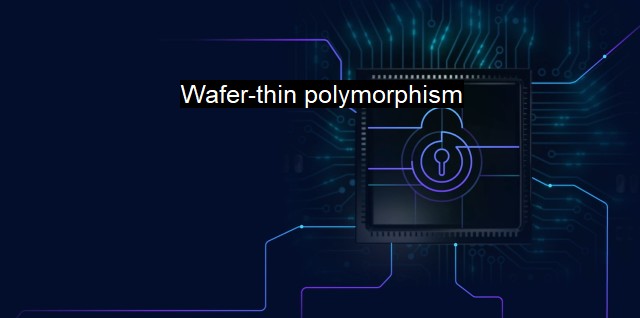What is Wafer-thin polymorphism?
Cracking the Code: Analyzing Wafer-thin Polymorphism in Cybersecurity and Antivirus Software
Wafer-thin polymorphism, a term borrowed from the advanced material sciences and used in the field of cybersecurity and antivirus software development, directly refers to the ability of computer viruses or malware to continuously change their identity to thwart detection by antivirus software.In the digital realm, polymorphism denotes the ability of an entity, such as a virus or malware, to alter its structure while retaining its fundamental functionalities. On a broad spectrum, polymorphism has been a feature of computer viruses since their advent. The intent of such transformation is to make identification and destruction hard for antivirus systems, serving as a protective shield.
Wafer-thin polymorphism represents a refined and advanced implementation of this technique, reducing the encoded changes to the minimum possible size - as thin as a wafer, figuratively. Malicious code, in this strategy, can have multiple forms, but prone to minimal changes, keeping it minimalistic and deceivingly simple.
The thin polymorphism follows a troubleshooting path. Unlike its predecessors that applied substantial modification strategies, the thinly created descendant infection hardly shows any change, appearing as a re-birth from its prior version. As most antivirus software rely on a signature database to identify codes that are distinctly malware, such nominal changes in viral strains would fail to provide a cryptographic signature, enabling them to bite the detection shield and penetrate system layers.
Wafer-thin polymorphism is a real challenge, forcing experts to stay alert, to constantly evolve their monitoring and prevention strategies. The polymorphic malware imitates the techniques of code obfuscation which includes encryption, junk code injection, or register reassignment, making the same code appear differently every time it runs, fooling signature-based detection systems.
Wafer-thin polymorphic malware also exploit the paradigmatic weaknesses in static analysis methodologies used by antivirus systems. Often, these entities choose a backdoor, encrypt their code, splice it, append it to an existing data executable in the system and blurs its polymorphic engine to avoid detection.
Polymorphism essentially seeks to undermine detection tools through mutation. Being metamorphic in nature, polymorphic virus evolution focuses on enhancing encryption or decryption keys - making the modus operandi nearly impossible to detect. Ironically enough, the wafer-thin technique, seemingly simple, proves to be a massive upgrade to the standard mutating malware that continue to pester the world of cybernetics.
Whether it is polymorphic or other types of mutation, their goal is simple and singular - evasion. They intend to evade detection at all costs, potentially leading to network infringement or information breach. The virus aims to blend into the system processes in a way that no red flags are raised, acting benign in the view of antivirus systems.
Implementing advanced machine learning an Artificial Intelligence (AI) could ensure robust, flexible and improvised approach to keep the detection systems effective against wafer-thin polymorphisms. Organizations should utilize memory scanning through AI-driven mechanisms, behavioral analysis and other advanced strategies to detect anomalies, abnormalities or unknown threats and protect their systems against the perpetual challenges posed by wafer-thin polymorphism.
Wafer-thin polymorphism, a state-of-art evasion technique in the cybercrime realm remained an elusive challenge for the cybersecurity industry. Regardless of the type, polymorphisms give headaches to programmers and database managers with their ingenious evasion techniques. These entities will remain a significant concern inspiring inclusive, iterative improvements in digital security frameworks and antivirus tools. Let's keep the fight on!

Wafer-thin polymorphism FAQs
What is wafer-thin polymorphism in the context of cybersecurity and antivirus?
Wafer-thin polymorphism refers to a sophisticated technique used by malware creators to alter the code of the virus just slightly to evade detection by antivirus programs. This way, the virus can infect a target system without being detected by the installed antivirus software.How does wafer-thin polymorphism differ from traditional polymorphism?
Traditional polymorphism involves a virus altering its code significantly to create new variants that are not identified by the antivirus software. Wafer-thin polymorphism, on the other hand, makes only small changes to the virus code, making it more challenging to detect.Can antivirus software detect wafer-thin polymorphic viruses?
Antivirus software has evolved to detect wafer-thin polymorphic viruses, but it remains a challenge. Security researchers continuously work to improve antivirus software by using advanced techniques such as machine learning, artificial intelligence and behavioral analysis to detect and stop such viruses.What can I do to protect my system from wafer-thin polymorphic viruses?
You can protect your system from wafer-thin polymorphic viruses by using a reputable antivirus software with up-to-date virus definitions. Ensure your operating system and applications are up to date with the latest security patches, avoid clicking on unknown links and downloading files from untrusted sources, and educate yourself about the latest cybersecurity threats.| | A | | | B | | | C | | | D | | | E | | | F | | | G | | | H | | | I | | | J | | | K | | | L | | | M | |
| | N | | | O | | | P | | | Q | | | R | | | S | | | T | | | U | | | V | | | W | | | X | | | Y | | | Z | |
| | 1 | | | 2 | | | 3 | | | 4 | | | 7 | | | 8 | | |||||||